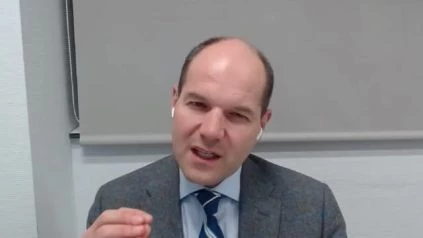Enrique M. Ocio, MD, Ph.D. of the Marqu̩s de Valdecilla University Hospital discusses ANCHOR (OP-104): Melflufen Plus Dexamethasone (dex) and Daratumumab (dara) or Bortezomib (BTZ) in Relapsed/Refractory Multiple Myeloma (RRMM) Refractory to an IMiD and/or a Proteasome Inhibitor (PI) РUpdated Efficacy and Safety.
Link To Study –
https://ashpublications.org/blood/article/136/Supplement%201/9/470073/ANCHOR-OP-104-Melflufen-Plus-Dexamethasone-dex-and
Context:
RRMM patients also develop resistance to conventional therapy, emphasizing the need for new treatments and new mechanisms of action (MOA). A first-in-class peptide-drug conjugate (PDC) that targets aminopeptidases and rapidly releases alkylating agents into tumor cells is melphalan flufenamide (melflufen).
In the phase 2 HORIZON study (OP-106; overall response rate [ORR], 29 percent; median progression-free survival [PFS], 4.2 months; median overall survival, 11.6 months) with reasonable safety, the efficacy of melflufen plus dex was demonstrated in highly pretreated RRMM pts refractory to pomalidomide and/or anti-CD38 monoclonal antibody (mAb) therapy (Richardson et al. EHA 2020. Abs. EP945). Dara and BTZ licensed agents to have non-overlapping MOA to melflufen, which supports the reasoning for combining these agents to resolve resistance to therapy. The efficacy and safety update is from the phase 1/2 ANCHOR (OP-104; NCT03481556) analysis of melflufen plus dex and dara or BTZ in RRMM.
Methodology:
Pts had to have RRMM and, with 1-4 previous therapy lines, be refractory to (or intolerant of) an IMiD and/or PI. Prior anti-CD38 mAb treatment could not have been obtained by Pts assigned to the dara arm; those assigned to the BTZ arm could not have been PI-refractory. On day 1 of each 28-day period, Melflufen (30, 40, or 20 mg intravenously [IV]) was administered. Dara arm: dara 16 mg/kg IV once weekly (8 doses), every 2 weeks (8 doses), then weekly every 4 weeks + dex 40 mg (20 mg if <75 years of age). BTZ arm: subcutaneous BTZ 1.3 mg/m2 + dex 20 mg (12 mg if ⇠75 years old) on days 1, 4, 8, and 11 + dex 40 mg (20 mg if ⇠75 years old) on days 15 and 22. Before progressive disease (PD) or unacceptable toxicity, the Pts are treated. The primary objectives were to assess the optimum combination dose of melflufen (phase 1) and to test the ORR dose (phase 2).
Outcomes:
33 pts were handled with melflufen (30 mg, n=6; 40 mg, n=27) plus dex and dara, and 10 pts with melflufen (30 mg, n=3; 40 mg, n=7) plus dex and BTZ, as of the data cutoff (06 April 2020).
Dara arm: the median age was 64 (range, 35-78) years, and the median number of previous lines was 2 years (range, 1-4). In 42% of pts, high-risk cytogenetics were present; 61% of pts were refractory to last therapy and 79% had previous autologous stem cell transplantation from the frontline (ASCT). The median period of treatment was 8.4 months (range, 1.0-23.7) and 45% of the pts received ⇠8 cycles; in the 30-mg and 40-mg cohorts, respectively, 4 pts (67%) and 5 pts (19%) were still being treated. Primarily due to PD, Pts discontinued treatment (36 percent ). Including 1 strict full answer, 1 total response, 10 very strong partial responses (VGPRs), and 11 PRs, ORR was 70%. The median PFS was 11.5 months after a median follow-up of 11.9 months (95 percent CI, 6.7-not reached [NR]). The median response period was 12.5 months (95 percent CI, 8.3-NR). Neutropenia (58 percent), thrombocytopenia (55 percent), and anemia (24 percent) were the most common grade 3/4 treatment-related adverse effects (TRAEs; ~5 pts); grade 3/4 nonhematologic TRAEs were rare. Extreme TEAEs, most notably influenza (9%), pneumonia, parainfluenza virus infection, and febrile neutropenia were encountered by 12 pts (36%), (6 percent each). Fatal AEs (myeloma progression and sepsis [1 pt], a general worsening of physical health) were encountered in two pts; sepsis was found to be consistent with study therapy.
The median age of the BTZ arm was 71 years (range 61-82) and the median number of previous lines was 2.5. (range, 1-4). In 40 percent of pts, high-risk cytogenetics were present; 70 percent of pts were refractory to last treatment; 30 percent received previous frontline ASCT, and 90 percent received a previous PI. The median treatment period was 5.6 months (range, 1.4-22.8); in the 30 mg and 40 mg cohorts, 2 pts (67 percent) and 5 pts (71 percent) were still on treatment, respectively. Due to PD, 2 pts were discontinued; 1 due to lack of efficacy. With 3 VGPRs and 3 PRs, the ORR was 60%. There is no mature PFS data yet. There were no dose-limiting toxicities found. Thrombocytopenia (80 percent), neutropenia (60 percent), and anemia (40 percent) were the most common grade 3/4 TRAEs (~2 pts); grade 3/4 nonhematologic TRAEs were rare. There were extreme TEAEs in six pts (60 percent), most commonly pneumonia (20 percent ). There were no deaths recorded.
The Conclusion:
As a triplet regimen with BTZ or dara, Melflufen plus dex has promising activity with low prognostic factors in heavily pretreated RRMM and has been well tolerated. Dara arm study of more pts with longer follow-up shows stable reactions with continued therapy.

